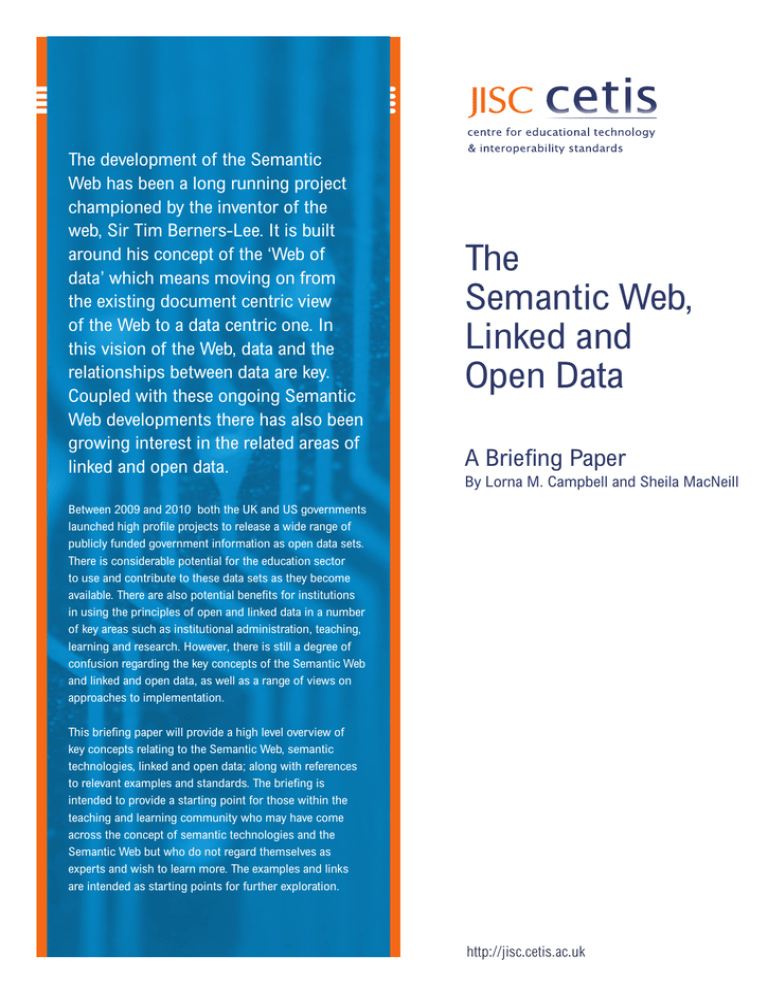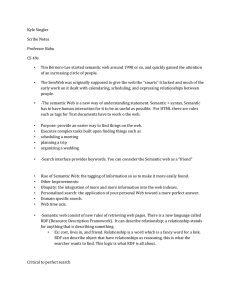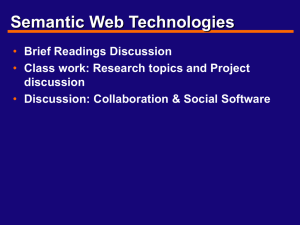
The development of the Semantic
Web has been a long running project
championed by the inventor of the
web, Sir Tim Berners-Lee. It is built
around his concept of the ‘Web of
data’ which means moving on from
the existing document centric view
of the Web to a data centric one. In
this vision of the Web, data and the
relationships between data are key.
Coupled with these ongoing Semantic
Web developments there has also been
growing interest in the related areas of
linked and open data.
The
Semantic Web,
Linked and
Open Data
A Briefing Paper
By Lorna M. Campbell and Sheila MacNeill
Between 2009 and 2010 both the UK and US governments
launched high profile projects to release a wide range of
publicly funded government information as open data sets.
There is considerable potential for the education sector
to use and contribute to these data sets as they become
available. There are also potential benefits for institutions
in using the principles of open and linked data in a number
of key areas such as institutional administration, teaching,
learning and research. However, there is still a degree of
confusion regarding the key concepts of the Semantic Web
and linked and open data, as well as a range of views on
approaches to implementation.
This briefing paper will provide a high level overview of
key concepts relating to the Semantic Web, semantic
technologies, linked and open data; along with references
to relevant examples and standards. The briefing is
intended to provide a starting point for those within the
teaching and learning community who may have come
across the concept of semantic technologies and the
Semantic Web but who do not regard themselves as
experts and wish to learn more. The examples and links
are intended as starting points for further exploration.
http://jisc.cetis.ac.uk
THE SEMANTIC WEB, LINKED AND OPEN DATA
The Semantic Web
DEFINITION
“The Semantic Web provides a common framework that allows
data to be shared and reused across application, enterprise, and
community boundaries. It is a collaborative effort led by W3C. It
is based on the Resource Description Framework (RDF).”
W3C, http://www.w3.org/2001/sw/
OVERVIEW
The World Wide Web Consortium (W3C) define the main goals
of the Semantic Web as follows:
“The Semantic Web is a Web of Data. The vision of the
Semantic Web is to extend the principles of the Web from
documents to data. Data should be accessed using the general
Web architecture using, e.g., URIs; data should be related to
one another just as documents (or portions of documents)
are already. This also means creation of a common framework
that allows data to be shared and reused across application,
enterprise, and community boundaries, to be processed
automatically by tools as well as manually, including revealing
possible new relationships among pieces of data.
In order to achieve theses goals, it is necessary to define and
describe the relations among data on the Web. This is not unlike
the usage of hyperlinks that connect the current page with
another page: the hyperlinks defines a relationship between
the current page and the target. On the Semantic Web, such
relationships can be established between any two named
resources or values and the relationship itself (i.e, the link) is
also named.
By contrast, a link on the traditional Web is not named, which
means that the significance or meaning of that link needs to be
deduced by the human reader. The naming and defining those
relations explicitly enables better and automatic interchange of
data. RDF, which is one of the fundamental building blocks of
the Semantic Web, gives a formal definition for that interchange.”
W3C, http://www.w3.org/2001/sw/SW-FAQ
This ability to dynamically describe complex and evolving
concepts, resources and relationships could have a profound
impact on how we all access and use data.
The Semantic Web is frequently represented by the following
“layer cake” diagram:
http://www.w3.org/2007/03/layerCake-small.png
Copyright © 2007 World Wide Web Consortium http://www.w3.org/,
(Massachusetts Institute of Technology http://www.csail.mit.edu/,
EuropeanResearch Consortium for Informatics and Mathematics http://www.
ercim.org/, Keio University http://www.keio.ac.jp/). All Rights Reserved.
Relevant Standards:
Uniform Resource Identifier (URI): http://www.ietf.org/rfc/rfc2396.txt
Resource Description Framework: http://www.w3.org/TR/REC-rdf
-syntax/
RDF Vocabulary Description Language 1.0: RDF Schema: http://www.
w3.org/TR/rdf-schema/
SPARQL Query Language for RDF: http://www.w3.org/TR/rdf
-sparql-query/
OWL 2 Web Ontology Language: http://www.w3.org/TR/owl2
-overview/
Rule Interchange Format Core Dialect: http://www.w3.org/TR/rif-core/
Simple Knowledge Organisation System: http://www.w3.org/TR/
skosreference/
EXAMPLES:
A Linked Open Data Resource List Management Tool for Undergraduate Students: http://www.w3.org/2001/sw/sweo/public/UseCases/
Talis/
Further Reading:
W3C Semantic Web Activity: http://www.w3.org/2001/sw/
W3C Semantic Web FAQ: http://www.w3.org/2001/sw/SW-FAQ
THE SEMANTIC WEB, LINKED AND OPEN DATA
Semantic technologies
DEFINITION
“Semantic technologies encode meaning separately from data
and content files, and separately from application code. This
enables machines as well as people to understand, share and
reason with them at execution time.”
Wikipedia, http://en.wikipedia.org/wiki/Semantic_technology
OVERVIEW
There are no hard and fast rules as to what does and does not
constitute semantic technologies, rather semantic technologies
may be placed along a continuum. Depending on how
information and semantics are modelled and expressed some
technologies are capable of considerably greater semantic
processing and reasoning than others.
Relevant Standards:
All the Semantic Web standards are relevant to semantic technolgies although few technologies will support them all. Other
relevant standards include:
RDF Site Summary 1.0: http://web.resource.org/rss/1.0/spec
Topic Maps ISO / IEC 13250: http://www.isotopicmaps.org/
EXAMPLES:
PROWE: developed a recommended metadata profile related to
a Friend Of A Friend (FOAF) vocabulary to allow remote, parttime tutors to collaborate using ‘blikis’ (a combination of blogs
and wikis).
http://www.prowe.ac.uk/
COMPENDIUM is a semantic, visual hypertext tool for supporting collaborative domain modelling and real time meeting
capture. It provides an intuitive visual map of issues, ideas and
arguments. It can be thought of as real time concept mapping,
but with additional native semantic hypertext functionality. Compendium is interoperable via XML with other technologies.
http://compendium.open.ac.uk
AWESOME is a semantic wiki run by the University of Leeds
with partners in the Universities of Coventry and Bangor under
the sponsorship of JISC. AWESOME aims at supporting the
academic writing process through social online mediated
environments. AWESOME uses both Web 2.0 technologies and
Semantic Web technologies such as tagging, folksonomies,
content annotation, blogs, chat, ontologies and semantically
enabled search.
http://awesome.alexlebek.co.uk/wiki/
Further Reading:
JISC Semantic Technologies in Teaching and Learning (SemTech)
Project: http://www.semtech.ecs.soton.ac.uk/
JISC SemTech Project Report: http://www.jisc.ac.uk/media/
documents/projects/semtech-report.pdf
CETIS Semantic Technology Resources: http://jisc.cetis.ac.uk/
topic/semantic_technologies
THE SEMANTIC WEB
Linked Data, linked data, linkable data
DEFINITION
“To make the Semantic Web or Web of Data a reality, it is
necessary to have a large volume of data available on the Web
in a standard, reachable and manageable format. In addition the
relationships among data also need to be made available. This
collection of interrelated data on the Web can also be referred to
as Linked Data. Linked Data lies at the heart of the Semantic Web:
large scale integration of, and reasoning on, data on the Web.”
W3C, http://www.w3.org/standards/semanticweb/data
OVERVIEW
There is currently considerable ambiguity as to the exact nature
of Linked Data. The debate primarily centres around whether
Linked Data must adhere to the four principles outlined in Tim
Berners-Lee’s “Linked Data Design Issues”, and in particular
whether use of RDF and SPARQL is mandatory. Some argue
that RDF is integral to Linked Data, others suggest that while it
may be desirable, use of RDF is optional rather than mandatory.
Some reserve the capitalised term Linked Data for data that is
based on RDF and SPARQL, preferring lower case “linked data”,
or “linkable data”, for data that uses other technologies. There
is currently no definitive practice.
In the recent JISC “Linked Data Horizon Scan” Paul Miller notes:
“Whilst the exact wording of these statements has changed
slightly since first expressed in 2006, and there remains
some doubt as to the strength of the requirement for specific
standards, the acronyms mask a simple yet powerful set
of behaviours;
• Name objects and resources, unambiguously;
• Make use of the structure of the web;
• Make it easy to discover information about the named object or
resource;
• If you know about related objects or resources, link to them too.
There is much to gain in embracing the philosophy behind these
rules, separately to adopting the standards and specifications
required to realise their full potential.”
Miller, http://linkeddata.jiscpress.org/
Since the vision of Linked Data pre-supposes a means for any
piece of data to be able to link to any other piece, perhaps the
distinction is simply between data that has been converted into
Linked Data already, and data that has not been converted yet,
but could be quite easily, perhaps on the fly.
Relevant Standards:
The fact that the “Linked Data Design Issues” paper is a
personal note by Tim Berners-Lee, and is not formally endorsed
by W3C also contributes to the ambiguity. The note states:
Uniform Resource Identifier (URI): http://www.ietf.org/rfc/rfc2396.txt
• Use URIs as names for things.
• Use HTTP URIs so that people can look up those names.
• When someone looks up a URI, provide useful information, using
Hypertext Transfer protocol (HTTP): http://www.w3.org/Protocols/
the standards (RDF, SPARQL).
• Include links to other URIs. so that they can discover more things.
“I’ll refer to the steps above as rules, but they are expectations
of behavior. Breaking them does not destroy anything, but
misses an opportunity to make data interconnected. This in turn
limits the ways it can later be reused in unexpected ways. It is
the unexpected re-use of information which is the value added
by the web.”
Berners-Lee, http://www.w3.org/DesignIssues/LinkedData.html
Resource Description Framework: http://www.w3.org/TR/REC
-rdf-syntax/
SPARQL Query Language for RDF: http://www.w3.org/TR/rdf
-sparql-query/
EXAMPLES:
DBpedia in essence, makes the content of Wikipedia available in
RDF. DBpedia not only includes Wikipedia data, but also incorporates links to other datasets on the Web, e.g. Geonames.
By providing those extra links (in the form of RDF triples) it allows applications to exploit the extra (and possibly more precise)
knowledge from other datasets. More importantly, by exploiting
the links within and between the datasets, applications can find
new information that would be very difficult to extract in any
other way.
http://www.w3.org/standards/semanticweb/data#examples
http://dbpedia.org
THE SEMANTIC WEB, LINKED AND OPEN DATA
Open Data
Linked Data which connects linked data across the web, is a
site that provides “a home for, or pointers to, resources from
across the Linked Data community”. Information, tutorials, data
sets, tools, events are available.
DEFINITION
There is no agreed standard definition for the term open data,
however the Open Knowledge Definition is beginning to gain
acceptance:
http://linkeddata.org
Further Reading:
The Open Knowledge Definition (OKD) sets out principles to
define “openness” in knowledge – “from sonnets to statistics,
genes to geodata”. This covers all forms of data as well as
content such as music, films, books, images and other material. It
can be summed up in the statement that “A piece of knowledge is
open if you are free to use, reuse, and redistribute it”.
When is Linked Data not Linked Data? A summary of the debate:
http://blogs.cetis.ac.uk/lmc/2010/03/16/when-is-linked-data-not
-linked-data-a-summary-of-the-debate/
W3C Semantic Web Linked Data: http://www.w3.org/standards/
semanticweb/data
Tim Berners-Lee’s Linked Data Design Issues: http://www.w3.org/
DesignIssues/LinkedData.html
OKD, http://www.opendefinition.org
OVERVIEW
Linked Data - the story so far: http://tomheath.com/papers/
bizer-heath-berners-lee-ijswis-linked-data.pdf
“Open Data is a philosophy and practice requiring that certain
data are freely available to everyone, without restrictions from
copyright, patents or other mechanisms of control. It has a
similar ethos to a number of other “Open” movements and
communities such as open source and open access. However
these are not logically linked and many combinations of practice
are found. The practice and ideology itself is well established
but the term “Open Data” itself is recent.”
Linked Data Horizon Scan: http://linkeddata.jiscpress.org
Wikipedia, http://en.wikipedia.org/wiki/Open_data
Surge
Radio
BBC
Playcount
Data
Musicbrainz
AudioScrobbler
MySpace
Wrapper
BBC Music
BBC
John
Peel
BBC
Later +
TOTP
Jamendo
Eurostat
Wikicompany
SemWebCentral
Doapspace
RDF
ohloh
FOAF
profiles
SW
Conference
Corpus
SIOC
Sites
BBC
Magnatune
US
Census
Data
Freebase
lingvoj
GEO
Species
DBLP
Berlin
Pub
Chem
IBM
UniRef
Reactome
LinkedCT
UniParc
Yago
Homolo
Gene
LAASCNRS
CiteSeer
DBLP
Hannover
UMBEL
Open
Cyc
Drug
Bank
Daily
Med
Taxonomy
PROSITE
GeneID
KEGG
LINKING OPEN DATA SET CLOUD
UniProt
Pfam
Diseasome
CAS
ChEBI
OMIM
Symbol
Gene
Ontology
Inter
Pro
UniSTS
Newcastle
IEEE
RDF Book
Mashup
W3C
WordNet
GovTrack
CORDIS
eprints
RKB
ECS
Southampton
DBpedia
Linked
GeoData
National
Science
Foundation
RAE
2001
Pisa
Linked
MDB
World
Factbook
Toulouse
DBLP
RKB
Explorer
Open
Calais
riese
ReSIST
Project
Wiki
Eurécom
IRIT
OpenGuides
Virtuoso
Sponger
Programmes
Budapest
BME
ACM
Revyu
flickr
wrappr
Project
Gutenberg
Resex
Semantic
Web.org
Flickr
exporter
QDOS
Crunch
Base
Geonames
Pub
Guide
ECS
Southampton
LIBRIS
HGNC
ProDom
Illustration copyright Richard Cyganiak July 2009
http://richard.cyganiak.de/2007/10/lod/
PDB
MGI
PubMed
As of July 2009
THE SEMANTIC WEB, LINKED AND OPEN DATA
The relationship between Linked Data and Open Data is currently
ambiguous. The JISC Linked Data Horizon Scan states:
“Linked Data may be Open, and Open Data may be Linked, but
it is equally possible for Linked Data to carry licensing or other
restrictions that prevent it being considered Open, or for Open
Data to be made available in ways that do not respect all of
Berners-Lee’s rules for Linking.”
Miller, http://linkeddata.jiscpress.org/
The concept of open data has risen in prominence in the UK
following the government’s 2009 / 2010 data.gov.uk initiative
which aims to open access to public-sector government data,
and slowly turn them into Linked Open Data where appropriate.
Relevant Standards:
In addition to those standards relevant to Linked Data,
arguably the standards that are most critical to Open Data
are open licences. Licensing of data needs to be explicit to
avoid any ambiguity in terms of use and re-use. There are
many differences worldwide relating to the copyright of data.
For example in the European Union database rights exist
automatically, whereas in the USA data is not covered by
existing copyright law. Guidance is available from a number of
sources including the following:
Creative Commons: http://creativecommons.org/
GNU Free Documentation License: http://www.gnu.org/copyleft/
fdl.html
Public Domain Dedication and License: http://www.opendatacommons
.org/licenses/pddl/
Science Commons Database Protocol: http://sciencecommons.org/
resources/faq/database-protocol
Guardian Data Store is a growing database of open data sets
used by the Guardian and available to download in a variety of
formats. It supports active community engagement and sharing
of how data sets are being used and reused.
http://www.guardian.co.uk/data-store
OpenStreetmap provides free worldwide geographical information such as maps. Currently the site uses creative commons
licensing. Global community contribution is actively encouraged.
http://wiki.openstreetmap.org/wiki/Main_Page
OS Open Data provides a selection of open Ordnance Survey
mapping datasets for Great Britain. In addition, an open API
(OS OpenSpace) also allows the integration of OS maps with
other websites. The OS Open Data licence is designed to be
interoperable with Creative Commons to enable the recombination of data.
http://www.ordnancesurvey.co.uk/oswebsite/opendata/index.html
BBC Backstage is a collection of open BBC data feeds and
APIs available for re-mixing and mash-ups. The site aims to
“encourage participation and support creativity through open
innovation.” There are some licence restrictions (mainly around
commercial use) which are clearly defined on the site.
http://ideas.welcomebackstage.com/data
Further Reading:
Open Data Commons: http://www.opendatacommons.org/
Open Knowledge Definition: http://www.opendefinition.org/okd/
Open Knowledge Foundation: http://www.okfn.org/
data.gov.uk: http://data.gov.uk/
Freedom to Research: Keeping Scientific Data Open, Accessible, and
Interoperable: http://sciencecommons.org/wp-content/uploads/
freedom-to-research.pdf
EXAMPLES:
MusicBrainz is a project that aims to create an open content
music database by capturing information about artists,
their recorded works, and the relationships between them.
MusicBrainz’s core data is in the public domain, and additional
content including moderation data is placed under the Open
Audio License. The server software is covered by the GNU
General Public License. The MusicBrainz client software library
is licensed under the GNU Lesser General Public License.
http://musicbrainz.org/
JISC CETIS, the Centre for Educational Technology and Interoperability
Standards, provides advice to the UK Higher and Post-16 Education
sectors on educational technology and standards.
© JISC CETIS 2010
PRODUCED JUNE 2010
Photographs copyright: © Award Creative, 2009. Images courtesy of JISC.
This work is licensed under a Creative Commons Attribution 3.0 License
(http://creativecommons.org/licenses/by/3.0/) and adheres to the JISC CETIS
publication policy (http://wiki.cetis.ac.uk/JISC_CETIS_Publication_Policy)






